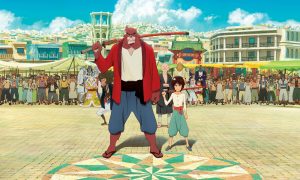
(Sight & Sound, BFI)
When Hosoda Mamoru’s The Boy and the Beast was released in Japan in summer 2015, it was at the commercial forefront of the country’s animation, even as Studio Ghibli went on hiatus. The film’s starting point – a child stumbling into a fantasy world – recalled Ghibli’s iconic Spirited Away (2001). The Boy and the Beast had tie-in adverts on television (where the film’s characters promoted green tea), and an exhibition in central Tokyo. This exhibition was near Shibuya’s “scramble junction”, Tokyo’s answer to Piccadilly or Times Square, where the film begins and where its spectacular climax takes place.
Hosoda’s film was a hit, beating Pixar’s Inside Out in Japan. However, The Boy and the Beast comes to Britain belatedly, overshadowed by the far greater success of Shinkai Makoto’s Your Name in 2016. While Hosoda’s film is excellent, there are clear reasons why Shinkai’s film did better.
One is sheer spectacle. The Boy and the Beast looks good, often recreating real locations with striking accuracy, but it lacks the extraordinary lushness that Your Name achieved in depicting country and city. To Western eyes, Hosoda’s film looks uneven, with some brilliant traditional animation in the film’s set-piece duels, but more rudimentary character work in lesser scenes. (Your Name also has uneven character work, but its scintillating backgrounds lift it up.)
Your Name is a heartfelt teen love story; Boy and the Beast is a buddy film. A runaway boy nicknamed Kyuta (“kyu” means nine, his age) stumbles down a Tokyo alley into a parallel world of beast people. Among them are samurai-style warriors who fight bonecrunching (but non-lethal) duels, often by swelling up in size and ramming each other. Here, Kyuta is adopted by an outsider, a self-taught, bear-like warrior called Kumatetsu. He’s voiced with funny, rambunctious gusto by Koji Yakusho, star of Shall We Dance? (1996) and The Eel (1997).
It’s soon obvious that Kyuta and Kumatetsu have very similar personalities, and can only progress by teaching each other, bonding as surrogate father and son. There’s an exquisite Marx Brothers-style routine where Kyuta persistently mimics his “master’s” fighting moves until he can finally predict and beat him. The film’s second half shows Kyuta as a teenager struggling to understand who he is, as he crosses back and forth between his two worlds and finds his long-lost human father. Like Akira (1988), this is an animation in which teen angst and rage manifest physically as uncontrollable monsters.
The film crams in a great deal of story, but successfully; there’s not been a film that sloshes between reality and fantasy so smoothly since Pan’s Labyrinth. The second half introduces a Tokyo girl, Kaede, who befriends Kyuta; this character has been criticised by some reviewers as being the hero’s supportive prop, but she’s impressively strong. In one scene, a fear-crazed Kyuta comes close to attacking her, pinning her to a fence; she strikes him hard in the face, then hugs him close. In the splendid climax, Kaede and Kyuta stand together as a monster menaces Tokyo; even by the standards of Japanese cinema, it’s a most unusual monster.
Boy and the Beast lacks the remarkable emotional intensity of Your Name. However, it should be said that Your Name is Shinkai’s sole hit to date, whereas Hosoda has steadily built a reputation since his first signature film, The Girl Who Leapt Through Time (2006). Hosoda’s next film will be reportedly about a 4 year-old boy who time-travels; it suggests the director’s staying with what he knows, not mimicking Shinkai’s success.
[amazon_link asins=’B074QSTKDX,B01GQ26LVW’ template=’ProductGrid’ store=’anime04c-21′ marketplace=’UK’ link_id=’5a85753f-5817-41c8-9767-0f2782c9e749′]